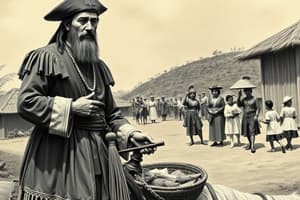Podcast
Questions and Answers
Nobles are also known as ______.
Nobles are also known as ______.
maharlica
Aliping saguiguilir may be sold and are often captives from ______.
Aliping saguiguilir may be sold and are often captives from ______.
war
The children of aliping namamahay cannot be made into ______.
The children of aliping namamahay cannot be made into ______.
slaves
If a culprit had relatives to help pay a debt, they would no longer be classified as aliping saguiguilir but become ______.
If a culprit had relatives to help pay a debt, they would no longer be classified as aliping saguiguilir but become ______.
During marriage, the children of maharlica and slaves will be divided; odd numbers belong to the ______.
During marriage, the children of maharlica and slaves will be divided; odd numbers belong to the ______.
All produce from cultivated lands of aliping belonged to their ______.
All produce from cultivated lands of aliping belonged to their ______.
The legitimate children receive equal ______ from their parents.
The legitimate children receive equal ______ from their parents.
Juan de Plasencia was a Franciscan missionary who first arrived in the Philippines in ______.
Juan de Plasencia was a Franciscan missionary who first arrived in the Philippines in ______.
If a maharlican father becomes a slave, his children also become ______.
If a maharlican father becomes a slave, his children also become ______.
The document written by Juan de Plasencia in 1589 is titled Customs of the ______.
The document written by Juan de Plasencia in 1589 is titled Customs of the ______.
Plasencia documented the customs and traditions of the colonized based on his own observations and ______.
Plasencia documented the customs and traditions of the colonized based on his own observations and ______.
A Maharlica's child with his slave had ______ in the inheritance.
A Maharlica's child with his slave had ______ in the inheritance.
The first printed book in the Philippines, written by Plasencia, is known as the Doctrina ______.
The first printed book in the Philippines, written by Plasencia, is known as the Doctrina ______.
During the Age of Discovery, colonizers aimed to enhance their superiority over the colonized and validate their duties and ______.
During the Age of Discovery, colonizers aimed to enhance their superiority over the colonized and validate their duties and ______.
If there are two children, the legitimate one receives ______ parts of share.
If there are two children, the legitimate one receives ______ parts of share.
In case of divorce, if the husband left the wife, he lost ______ of the dowry.
In case of divorce, if the husband left the wife, he lost ______ of the dowry.
De Plasencia attempted to obtain the 'simple truth' through an 'informed ______'.
De Plasencia attempted to obtain the 'simple truth' through an 'informed ______'.
The text highlights two important figures: the observer, de Plasencia, and the observer's subject, the ______.
The text highlights two important figures: the observer, de Plasencia, and the observer's subject, the ______.
They celebrate worship in the large house of a ______.
They celebrate worship in the large house of a ______.
The logic of binarism in the text refers to the division between the ______ and the Other.
The logic of binarism in the text refers to the division between the ______ and the Other.
Bathala, whom they worship, signifies ______.
Bathala, whom they worship, signifies ______.
The poetic song sung during rituals is performed by the officiating priest called ______.
The poetic song sung during rituals is performed by the officiating priest called ______.
The dead is buried ______ his house.
The dead is buried ______ his house.
They mourn for ______ days before internment.
They mourn for ______ days before internment.
Pedro Chirino was a missionary to the Tagalos and ______.
Pedro Chirino was a missionary to the Tagalos and ______.
Chirino studied civil and canon law in ______.
Chirino studied civil and canon law in ______.
Since the conversion of the natives to Catholicism, Chirino noticed an improvement in the ______.
Since the conversion of the natives to Catholicism, Chirino noticed an improvement in the ______.
According to Chirino, the seasons have been given their proper ______ since the arrival of the Spaniards.
According to Chirino, the seasons have been given their proper ______ since the arrival of the Spaniards.
William Henry Scott used seven basic documents for his study, including Chirino's Relacion de las ______ Filipinas.
William Henry Scott used seven basic documents for his study, including Chirino's Relacion de las ______ Filipinas.
Renato Constantino wrote 'The Philippines: a past ______'.
Renato Constantino wrote 'The Philippines: a past ______'.
Father Plasencia described Filipinos as being divided into four social conditions or ______.
Father Plasencia described Filipinos as being divided into four social conditions or ______.
According to Constantino, the barangay was not a political ______.
According to Constantino, the barangay was not a political ______.
In colonial situations, the relationship of the colonizer and the colonized flows in both but unequal directions; the former being the dominant, while the latter is the ______.
In colonial situations, the relationship of the colonizer and the colonized flows in both but unequal directions; the former being the dominant, while the latter is the ______.
Fray Juan de Plasencia was known as a defender of the rights of the native ______.
Fray Juan de Plasencia was known as a defender of the rights of the native ______.
Fray Juan de Plasencia was born in the region of ______, Spain in the early 16th century.
Fray Juan de Plasencia was born in the region of ______, Spain in the early 16th century.
The document was written upon the request of ______ de Vera, governador general from 1584-1590.
The document was written upon the request of ______ de Vera, governador general from 1584-1590.
Fray Juan de Plasencia came together with the first batch of ______ missionaries in the Philippines.
Fray Juan de Plasencia came together with the first batch of ______ missionaries in the Philippines.
One of the notable works of Fray Juan de Plasencia is the ______ de la Doctrina Cristiana, published in 1581.
One of the notable works of Fray Juan de Plasencia is the ______ de la Doctrina Cristiana, published in 1581.
Fray Juan de Plasencia wrote the ______ Al Rey in 1585, outlining the basic principles behind the Reduccion System.
Fray Juan de Plasencia wrote the ______ Al Rey in 1585, outlining the basic principles behind the Reduccion System.
Fray Juan de Plasencia died in the year ______.
Fray Juan de Plasencia died in the year ______.
Flashcards are hidden until you start studying
Study Notes
Historical Context of "Customs of the Tagalogs"
- Written in 1589 by Juan de Plasencia, a Spanish Franciscan missionary.
- Commissioned by Governor-General Santiago de Vera to document Filipino customs and traditions.
- Aimed to provide an informed observation of Tagalog life while avoiding conflicting reports.
Authorship and Perspective
- Juan de Plasencia was a non-Tagalog, reflecting a colonial perspective and potential biases.
- His mission-oriented approach sought to validate colonial practices and superiority.
- Authorship plays a crucial role in interpreting the text, emphasizing the dynamics between the observer (colonizer) and the observed (colonized).
Social and Economic Stratifications
- The Tagalog society was structured into various social classes, including:
- Nobles (Maharlica): Free-born, exempt from taxes, required to support their leaders in warfare.
- Aliping Namamahay: Free individuals serving nobles, living independently but ensuring allegiance.
- Aliping Saguiguilir: Enslaved individuals, often captives, bound to serve masters without rights to their labor's produce.
- Status could change, notably through marriage, which could elevate enslaved individuals to free status.
Debt and Loans
- Economic interactions often led to servitude through debt, where individuals worked off their obligations.
- If debts were settled, individuals could regain their free status.
- Enforced servitude for debtors and their families until dues were paid was a common practice.
Marriage and Inheritance
- Inter-class marriages complicated inheritance rights between legitimate and illegitimate children, impacting wealth distribution.
- Dowries played a significant role in marital arrangements, with explicit rules on inheritance based on social status.
Religious Practices
- Indigenous worship involved communal celebrations rather than temple-based sacrifices.
- Major deities included Bathala, representing a creator god, along with celestial bodies like the sun and moon.
- Rituals were led by priests with distinct roles, such as Catalonan (honorable) and Mangangaway (associated with deceit).
Funerary Customs
- The dead were buried near their home, with mourning rituals preceding burial.
- Cultural practices dictated that the deceased were laid in boats, highlighting their beliefs regarding the afterlife.
Comparative Analysis of Sources
- The text by Juan de Plasencia is compared to later works by figures like Pedro Chirino and historians Scott and Constantino, showing evolving interpretations of Philippine society.
- Contrasting views on social stratification demonstrate differing assessments of Tagalog society, particularly regarding issues like peonage versus slavery.
Contributions of Juan de Plasencia
- He advocated for language inculturation and produced significant works in catechism.
- As a pedagogue, he played a role in establishing schools and communities amidst the colonial landscape.
- Recognized for contributing to the understanding of Filipino customs while defending the rights of native Filipinos, illustrating his multifaceted role as a missionary and ethnographer.
Studying That Suits You
Use AI to generate personalized quizzes and flashcards to suit your learning preferences.




